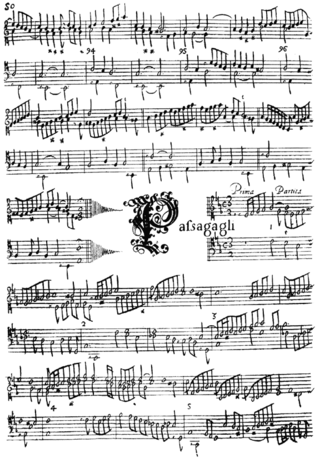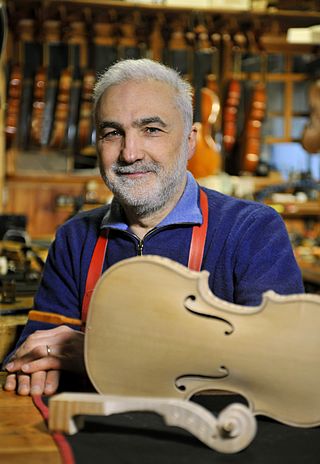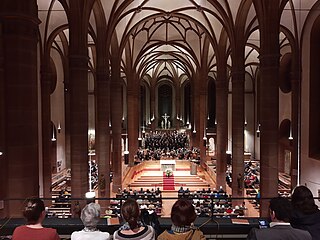
Muzio Filippo Vincenzo Francesco Saverio Clementi was an Italian-British composer, virtuoso pianist, pedagogue, conductor, music publisher, editor, and piano manufacturer, who was mostly active in England.

Mieczysław Karłowicz was a Polish composer and conductor.

The passacaglia is a musical form that originated in early seventeenth-century Spain and is still used today by composers. It is usually of a serious character and is often based on a bass-ostinato and written in triple metre.

The Stabat Mater is a 13th-century Christian hymn to Mary that portrays her suffering as Jesus Christ's mother during his crucifixion. Its author may be either the Franciscan friar Jacopone da Todi or Pope Innocent III. The title comes from its first line, "Stabat Mater dolorosa", which means "the sorrowful mother was standing".

François de Fossa was a French classical guitarist and composer.

Karol Szymanowski's Stała matka bolejąca , Op. 53, was composed in 1925 and 1926. Scored for soprano, alto and baritone soloists, SATB choir and orchestra, it sets Jozef Janowski's Polish translation of the Marian hymn in six movements. His first composition to a liturgical text, it is characteristic of his late period in being partly based on Polish melodies and rhythms; a stay in the Tatras mountains, at Zakopane, in 1922 had led him to describe Polish folk music as "enlivening [in] its proximity to Nature, [in] its force, [in] its directness of feeling, [in] its undisturbed racial purity." Indeed, Szymanowski's use of Polish musical elements together with the Polish translation here is unique.
Sandrine Piau is a French soprano. She is particularly renowned in Baroque music although also excels in Romantic and modernist art songs. She has the versatility to perform works from Vivaldi, Handel, Mozart to Schumann, Debussy, and Poulenc. In addition to an active career in concerts and operas, she is prolific in studio recordings, primarily with Harmonia Mundi, Naïve, and Alpha since 2018.

Roberto Regazzi is a notable contemporary violin maker and scholar who received his initiation in the craft from Otello Bignami. Regazzi lives and works in Bologna.
Giovanni Benedetto Platti was an Italian Baroque composer and oboist.

Anne Louise Brillon de Jouy was a French musician and composer. Born in Paris, she lived in Passy and played and composed for the harpsichord and the piano. She learned to play the harpsichord as a child.

Antonín Dvořák's Stabat Mater, Op. 58 (B. 71), is an extended setting for vocal soloists, choir and orchestra of the 20 stanzas of the Stabat Mater sequence. Dvořák sketched the composition in 1876 and completed it in 1877. It has been characterized as a sacred cantata and as an oratorio, and consists of ten movements of which only the first and the last are thematically connected. Its total performance time is around 85 minutes.

Musica notturna delle strade di Madrid, Opus 30 No. 6, is a quintettino (quintet) for stringed instruments, by Luigi Boccherini, the Italian composer in service to the Spanish Court from 1761 to 1805.

Guido Rimonda is an Italian violinist and conductor.

The String Quintet in E major, Op. 11, No. 5 , by Luigi Boccherini was written in 1771 and published in 1775. The quintet is famous for its minuet third movement which is frequently played as a standalone piece outside of the context of the full quintet.

Stabat Mater (P.77) is a musical setting of the Stabat Mater sequence, composed by Giovanni Battista Pergolesi in 1736. Composed in the final weeks of Pergolesi's life, it is scored for soprano and alto soloists, violin I and II, viola and basso continuo.

Flavio Emilio Scogna is an Italian composer and conductor.
Louis Picquot was a 19th-century French musicographer, author of the first biography of Luigi Boccherini and a catalogue of Boccherini's works.

Stabat Mater by Alessandro Scarlatti is a religious musical work composed for two voices (soprano/alto), two violins and basso continuo, in 1724, on a commission from the Order of Friars Minor, the "Knights of the Virgin of Sorrows" of the Church of San Luigi in Naples for Lent














